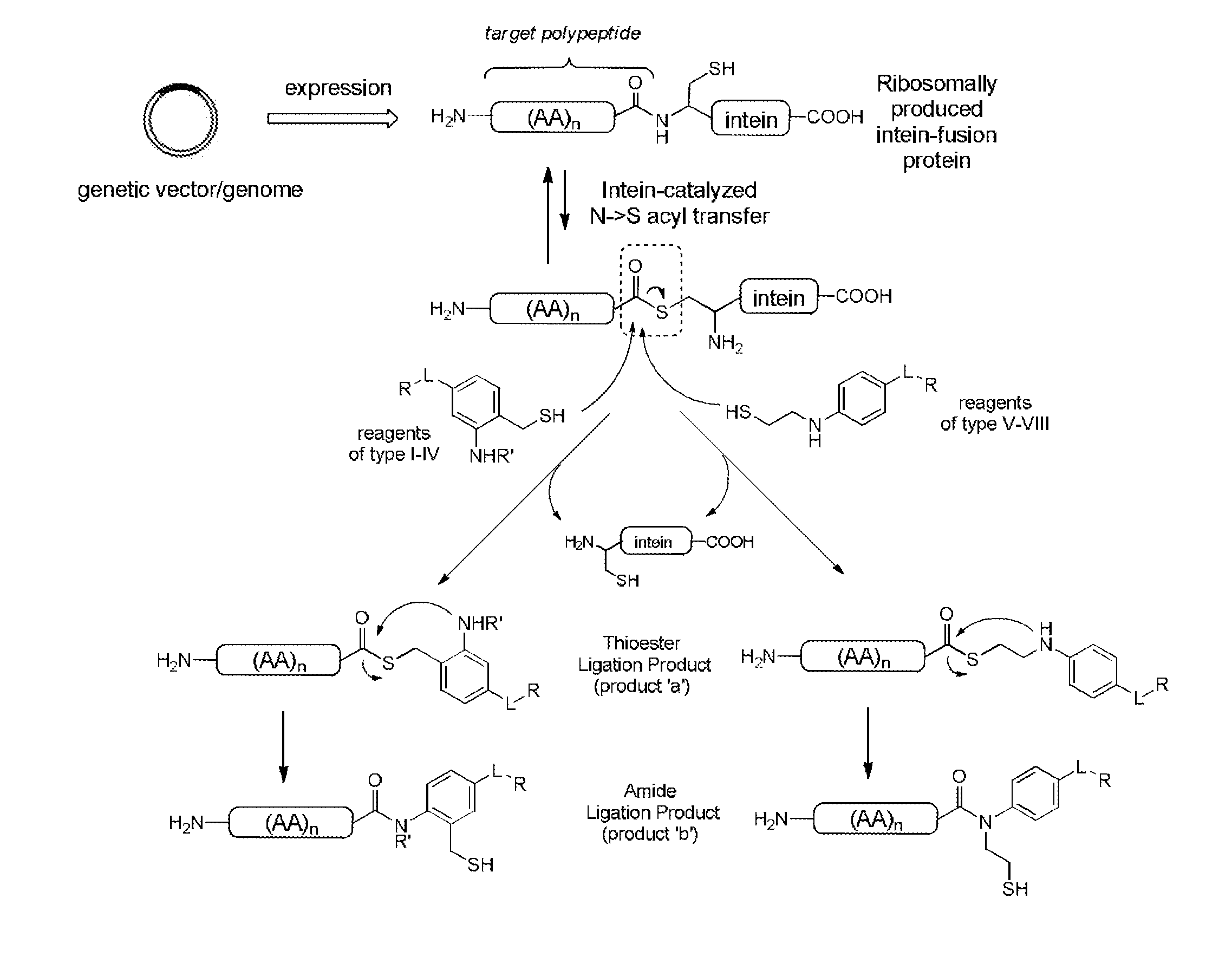Methods and compositions for site-specific labeling of peptides and proteins
a technology of site-specific labeling and peptides, which is applied in the field of method and composition for site-specific labeling of peptides and proteins, can solve the problems of affecting biological function, dynamics, conformational properties, and/or cellular localization, and preventing accurate control of site-selectivity of reaction,
- Summary
- Abstract
- Description
- Claims
- Application Information
AI Technical Summary
Benefits of technology
Problems solved by technology
Method used
Image
Examples
example 1
Synthesis of 1-amino-2-(mercaptomethyl)-aryl compounds
[0400]This example demonstrates the synthesis of a protected amino-thiol-aryl precursor for the generation of 1-amino-2-(mercaptomethyl)-aryl reagents for protein / peptide functionalization using the methods provided herein. In particular, this example illustrates how a N- and S-protected, carboxylic group-functionalized 1-amino-2-(mercaptomethyl)-aryl moiety can be prepared, which can be used as synthetic intermediate for the preparation of reagents of general formula (I) as further described in Examples 6 and 7. Additionally, this protected intermediate can converted to 3-amino-4-(mercaptomethyl)benzoic acid, which can be used directly for protein functionalization as described in Example 10.
[0401]As described in the scheme of FIG. 2, the target compound 3-amino-4-(mercaptomethyl)benzoic acid (11) was prepared starting from methyl 3-amino-4-methylbenzoate 1 in five steps. Boc protection of the amino group in 1, followed by benzy...
example 2
Synthesis of additional 1-amino-2-(mercaptomethyl)-aryl Compounds
[0405]This example demonstrates the synthesis of compounds of general formula (II) which can be used for the purpose of protein / peptide functionalization using the methods provided herein. As described by the scheme in FIG. 3, the desired reagent 3-(mercaptomethyl)-4-amino-benzoic acid (17) from prepared starting from methyl 4-amino-3-methylbenzoate 12 in five steps. Introduction of a tertiary butyl carbamate protecting group to the aryl amino group followed by benzylic bromination and introduction of a thiol functionality through substitution of the benzylic position using the reagent triphenylmethylmercaptan yielded a N-Boc, S-trityl protected intermediate 15. Hydrolysis of the methyl ester to the free carboxylic acid using aqueous lithium hydroxide could provide a convenient chemical handle, which can be used for coupling various chemical entities (fluorescent dyes, affinity tags, etc.) to the amino-thiol moiety. Th...
example 3
Synthesis of Oxyamine-Comprising Protein Labeling Reagents
[0410]This example demonstrates the synthesis of a protein labeling reagent of general formula (I) comprising a bioorthogonal oxyamine functional group (—ONH2) as the R group. According to the methods described herein, this reagent can be used for linking a target polypeptide to a bioorthogonal oxyamino functionality, which can be used for further coupling a chemical species to the polypeptide via oxime ligation.
[0411]As described in the scheme in FIG. 2, methyl ester 2 was reduced to a benzylic alcohol using Lithium Aluminum Hydride. This benzylic alcohol was activated with methanesulfonyl chloride to prepare the mesylate derivative 4 which was then reacted with N-Boc-hydroxylamine to produce the protected intermediate. This compound was subsequently deprotected with trifluoroacetic acid in the presence of triisopropylsilane to yield the oxyamino-containing reagent 8.
Experimental Details for Example 3
[0412]2 (20.32 g, 48 mmo...
PUM
| Property | Measurement | Unit |
|---|---|---|
| temperature | aaaaa | aaaaa |
| temperature | aaaaa | aaaaa |
| ambient temperature | aaaaa | aaaaa |
Abstract
Description
Claims
Application Information
 Login to View More
Login to View More - R&D
- Intellectual Property
- Life Sciences
- Materials
- Tech Scout
- Unparalleled Data Quality
- Higher Quality Content
- 60% Fewer Hallucinations
Browse by: Latest US Patents, China's latest patents, Technical Efficacy Thesaurus, Application Domain, Technology Topic, Popular Technical Reports.
© 2025 PatSnap. All rights reserved.Legal|Privacy policy|Modern Slavery Act Transparency Statement|Sitemap|About US| Contact US: help@patsnap.com



